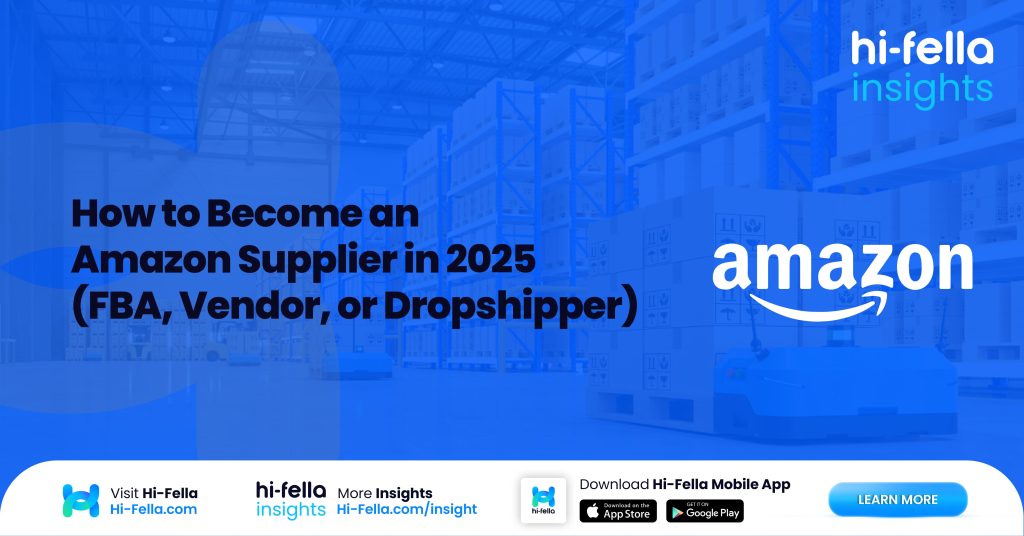Amazon remains one of the largest and most dynamic e-commerce platforms in the world, offering immense opportunities for businesses of all sizes to sell their products. Whether you’re a small business looking to tap into Amazon’s massive customer base or a larger supplier seeking to expand your reach, there are multiple ways to become an Amazon supplier. In 2025, the most common methods are Fulfilled by Amazon (FBA), Vendor Central, and Dropshipping. Each model offers distinct advantages and challenges, and understanding which path suits your business goals is essential.
In this article, we will explore the different Amazon supplier models, guide you through the steps to becoming a supplier in each of these categories, and provide tips on how to succeed in the competitive Amazon marketplace.
Table of Contents
Understanding the Amazon Supplier Models: FBA, Vendor Central, and Dropshipping
To begin, it’s important to understand the three main ways to become an Amazon supplier:
1. Fulfilled by Amazon (FBA)
Fulfilled by Amazon (FBA) is one of the most popular models for new and established sellers alike. In this model, you, as the supplier, send your products to Amazon’s fulfillment centers, and Amazon takes care of storing, packaging, and shipping the products directly to customers. Amazon also handles customer service and returns.
Eligibility: To become an FBA seller, you must have an Amazon Seller Account. FBA is open to any Amazon seller who meets the platform’s requirements and wants to take advantage of Amazon’s logistics infrastructure.
Benefits:
- Amazon handles the logistics: storage, packing, shipping, and returns.
- Access to Amazon Prime customers.
- Amazon’s customer service handles queries and returns.
- Increased visibility in Amazon’s search results.
Challenges:
- Fees: There are fees for storage, handling, and fulfillment, which vary based on product size and weight.
- Responsibility for inventory management and restocking to avoid stockouts.
2. Vendor Central
Becoming a Vendor on Amazon means you sell your products directly to Amazon in bulk, and Amazon becomes the retailer. The platform then handles the selling and fulfillment of those products on Amazon.com.
Eligibility: Vendor Central is an invitation-only program, which means you cannot simply sign up to become a vendor. Amazon typically invites manufacturers or large suppliers who meet their standards or who are in categories Amazon wants to expand.
Benefits:
- Amazon buys your products directly, allowing you to sell in bulk.
- Higher-volume sales and exposure on Amazon’s website.
- Opportunity to negotiate for exclusive deals and discounts.
Challenges:
- Limited pricing control: Amazon dictates the price at which your product sells.
- Strict compliance with Amazon’s payment schedules and shipping expectations.
- No access to Amazon’s FBA services, so you’re responsible for your logistics.
3. Dropshipping
Dropshipping on Amazon allows you to sell products without holding inventory. When a customer places an order, you purchase the item from a third-party supplier, who ships the product directly to the customer.
Eligibility: Dropshipping is available to Amazon sellers, but there are specific policies you must adhere to. Amazon’s dropshipping policy requires that you be the seller of record, which means you must manage customer service and returns.
Benefits:
- Low upfront costs: No need to buy or store inventory.
- Easy to scale: You can list products without worrying about inventory levels or warehouse space.
- Flexibility in product offering.
Challenges:
- Finding reliable suppliers: You are dependent on third-party suppliers for product quality and delivery.
- Logistics and customer service: While you don’t handle the shipping, you are still responsible for customer queries, returns, and ensuring the third-party supplier fulfills orders correctly.
- Risk of account suspension: Amazon has strict policies around dropshipping, and failing to follow them can result in account suspension.
The Step-by-Step Guide to Becoming an Amazon FBA Seller
If you’re interested in the FBA model, here’s a step-by-step guide on how to become an FBA seller on Amazon:
1. Set Up Your Amazon Seller Account
To start, you’ll need to sign up for an Amazon Seller account. This account can be either Individual or Professional, depending on your sales volume. Professional accounts are more suitable for high-volume sellers and come with a monthly fee but offer access to more selling tools.
2. List Your Products
Once your account is set up, you can start listing your products. When you choose to use FBA, you’ll need to select the FBA option for each product. Amazon will provide guidelines on how to create listings, including product descriptions, pricing, and images.
3. Send Inventory to Amazon
After your listings are live, you’ll need to ship your inventory to Amazon’s fulfillment centers. Amazon provides detailed instructions on how to package and label products for FBA, and you can track shipments through the Seller Central dashboard.
4. Optimize Your Inventory Management
As an FBA seller, it’s important to keep your inventory stocked to avoid running out of products. Use Amazon’s tools to monitor inventory levels and make adjustments to your supply chain as needed. Understanding demand and managing restocks is key to staying competitive.
5. Market and Sell Your Products
With your products live and fulfilled by Amazon, it’s time to market them. Leverage Amazon Advertising, including sponsored products and sponsored brand ads, to increase visibility and drive traffic to your listings. FBA products typically rank higher in Amazon search results, but paid ads can boost exposure further.
6. Monitor Sales and Customer Feedback
FBA allows you to leverage Amazon’s Prime customer base, which can drive increased sales. Be sure to monitor your sales, review customer feedback, and optimize your listings based on performance metrics.
How to Become an Amazon Vendor: Getting Accepted into Vendor Central
Becoming a vendor on Amazon provides the opportunity to sell in bulk directly to the retailer. Here’s what you need to know about the Vendor Central program:
1. Get an Invitation
As mentioned, Vendor Central is by invitation only. Amazon typically reaches out to suppliers they want to work with, so you cannot directly apply. However, you can increase your chances by reaching out to Amazon or using a third-party consultant to help pitch your products.
2. Product Submission
Once invited, you’ll need to submit your product catalog to Amazon for approval. Amazon will assess the quality of your products, their marketability, and potential pricing.
3. Agree to Terms
Amazon will send you a contract with detailed terms about pricing, delivery expectations, payment terms, and other business guidelines. Negotiating favorable terms is critical to ensure your business is protected.
4. Deliver and Ship Products
As a vendor, you’re responsible for fulfilling large orders in bulk. You’ll ship directly to Amazon’s warehouses, and they’ll handle everything from there, including listing your products on their site.
Starting as an Amazon Dropshipper: Pros, Cons, and the Process
For those who prefer not to deal with inventory, dropshipping is an attractive option. Here’s how you can get started:
1. Set Up Your Account
First, you need to create a seller account on Amazon and decide whether you want to apply for Individual or Professional plans. While the Individual plan has no monthly fees, the Professional plan provides more features and flexibility for dropshippers.
2. Find Reliable Suppliers
You must partner with trusted suppliers who will handle order fulfillment. Use platforms like AliExpress, SaleHoo, or Worldwide Brands to find reputable suppliers. It’s essential to work with suppliers who can consistently meet Amazon’s shipping standards.
3. List Products and Manage Customer Service
Once you have your suppliers, list products on Amazon, ensuring you follow Amazon’s dropshipping policy. Make sure you manage your customer service, including returns and inquiries, even though you are not responsible for fulfilling orders directly.
4. Follow Amazon’s Dropshipping Policies
Amazon has strict rules regarding dropshipping, and failing to comply can result in account suspension. Ensure you:
- Are the seller of record.
- Do not use another retailer’s name or address on the packing slip.
- Maintain a consistent level of customer service.
Join Hi-Fella Today!
Navigating the path to becoming an Amazon supplier can be overwhelming, but with the right strategy, it can lead to significant business growth. Whether you’re using FBA, Vendor Central, or Dropshipping, Hi-Fella can help streamline your supplier journey.
Hi-Fella connects suppliers with a global network of buyers and provides tools to manage logistics, inventory, and relationships. By leveraging Hi-Fella’s platform, you can expand your reach, optimize your supply chain, and stay competitive in the rapidly evolving e-commerce market.
Start building your business on Amazon today and connect with new opportunities by joining Hi-Fella!








